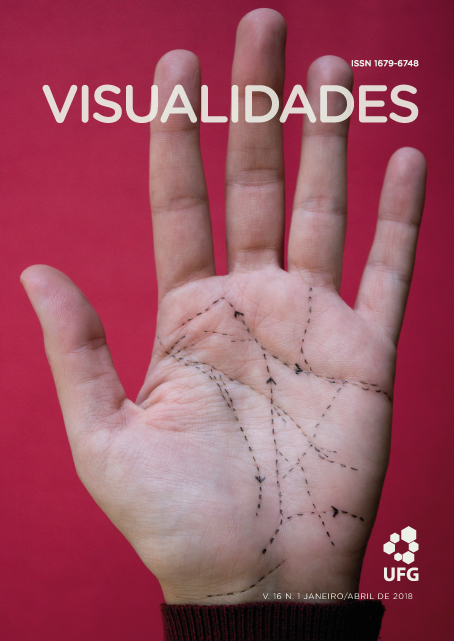O encantamento dos artefatos: trânsitos e mudanças de espaços e significados
DOI:
https://doi.org/10.5216/vis.v16i1.47299Keywords:
Circulação de artefatos, museus, povo TapirapéAbstract
This text is the result of an ethnography carried out on the artifacts of the Tapirapé indigenous people. For this people, artifacts and body painting are shamanic knowledge. The shaman is responsible for bringing these knowledge of the spirits to them. In addition to decorating and embellishing the body, artifacts can protect from spirits, cause disease and death. Some artifacts are considered enchanted and must be destroyed after the ritual, and be preserved and exhibited in museums.
Downloads
References
ARGAN, Giulio Carlo. Arte Moderna. SP: Cia. das Letras, 1992.
BALDUS, Herbert. Tapirapé: Tribo tupi no Brasil Central. SP: Edusp, Companhia Editora Nacional, 1970.
BELTING, Hans. O fim da História da Arte: Uma revisão dez anos depois. SP: Cosac nayf, 2003.
BOAS, Franz. A Arte Primitiva. RJ: Mauad X, 2015.
CARVALHO, Aivone. O museu na Aldeia: Comunicação e transculturalismo no diálogo museu e aldeia. Campo Grande; UCDB, 2006.
CLIFFORD, James. A experiência etnográfica: antropologia e literatura no século XX. RJ: Editora UFRJ, 1998.
DANTO, Arthur C. A transfiguração do lugar-comum: uma filosofia da arte. SP: Cosac & Naify, 2005.
______. Após o Fim da Arte: a arte contemporânea e os limites da historia. SP:
Odysseus Editora, 2006.
DURAND, Jean-Yves. Este obscuro objecto do desejo etnográfico: o museu. In,
Etnográfica [Online], vol. 11 (2) | 2007. Disponível online,
file:///C:/Users/user/Downloads/etnografica-2024-vol-11-2-este-obscuro-objecto-dodesejo-etnografico-o-museu.pdf. Acessado em 17 de janeiro de 2016.
GALLOIS, Dominique T. Ilustrações: índios Wajapi. Kusiwa: pintura corporal e
arte gráfica wajãpi. RJ: Museu do Índio-FUNAI/APINA/CTI/NHII-USP, 2002.
GELL, Alfred. Art and Agency: An Anthropological Theory. Oxford: Clarendon Press, 1998.
________. A rede de Vogel, armadilhas como obras de arte e obras de arte como armadilhas. Arte e Ensaios: Revista do Programa de Pós-Graduação em Artes Visuais, Rio de Janeiro: Escola de Belas Artes da UFRJ, ano 8, n. 8, p. 174-191, 2001.
GOLDSTEIN, Ilana. Reflexões sobre a arte "primitiva": o caso do Musee Branly. In. Horiz. antropol, v. 14, n. 29, p. 279-314, June. Porto Alegre: UFRGS, 2008.
HONTHEIM, Astrid. Imagination behind shape. The invisible content of Asmat artefacts. Anthropological Forum 20. Australia. 2010, p 235 - 249.
INGOLD, Tim. Trazendo as coisas de volta à vida: emaranhados criativos num mundo de materiais. Horiz. antropol. Porto Alegre , v. 18, n. 37, p. 25-44, June 2012 .
KOSUTH, J. Art after philosophy and after. London: The MIT Press, 1991.
LAGROU, Els. A fluidez da forma: arte, alteridade e agência em uma sociedade amazônica (Kaxinawa, Acre). RJ: TopBooks, 2007.
________. Arte ou artefato? Agencia e significado nas artes indígenas. In: Proa-Revista de Antropologia e Arte [on-line]. Ano 02, vol.01, n. 02, nov. 2010. Disponível
em:http://www.ifch.unicamp.br/proa/DebatesII/elslagrou.html, acesso em: 03/09/2011.
LEIRIS, Michel Leiris. A África fantasma. SP: CosacNaify, 2007.
LEVI-STRAUSS, Claude. O pensamento Selvagem. SP: perspectiva. 2011.
_________. La vía de las máscaras. Ciudad del Mexico: Siglo XXI editores, 2011.
_________. Tristes trópicos. SP: Companhia das letras, 2010.
MARTINS, Raimundo. Narrativas visuais: Imagens, visualidades e experiências educativas In. VIS - Revista do programa de Pós-graduação em arte da UNB. n. 8, v. Brasília, janeiro/junho, 2009.
MITCHELL, W. J. T. Picture theory. Chicago and London: University of Chicago Press, 1994.
MORAIS, Frederico. Artes plásticas: A crise da hora atual. RJ: Edt. Paz e Terra,1975.
PRICE, Sally. Son los antropólogos ciegos frente al arte? Quaderns de l'Institut Català d'Antropologia [en linia], Num. 21, 2005, p. 15-31.
http://www.raco.cat/index.php/QuadernsICA/article/view/109905/169825 [Consulta:
-11-15]
________. Primitive Art in Civilized Places. Chicago: University of Chicago press,
________. Paris Primitive. Jacques Chirac’s Museum on the Quai Branly. Chicago- London: University of Chicago Press, 2007.
SUCKAER, Ingrid. Arte indígena contemporáneo: dignidad de la memoria y apertura de cánones. Ciudad de México: FONCA e Samsara, 2017.
WAGLEY, Charles. Lágrimas de boas vindas: os índios Tapirapé do Brasil Central.
SP: Edusp, 1988.
VELTHEN, Lucia Hussak Van. O belo é a fera: A estética da produção e da predação entre os Wayana. Lisboa: Museu Nacional de etnologia; Assírio & Alvim, 2003.
VIDAL, Lux. Grafismo indígena. Estudos de Antropologia Estética. SP: Studio
Nobel/Edusp/FAPESP, 1992.
Downloads
Published
How to Cite
Issue
Section
License

This work is licensed under a Creative Commons Attribution 4.0 International License .
Authors who publish in this journal agree to the following terms:
a. Authors retain the copyright and grant the journal the right of first publication, with the work simultaneously licensed under the Creative Commons Attribution 4.0 License which allows the sharing of work with acknowledgment of authorship and initial publication in this journal.
b. Authors are authorized to take additional contracts separately, for non-exclusive distribution of the version of the work published in this journal (eg publish in institutional repository or as a book chapter), with acknowledgment of authorship and initial publication in this journal.
c. Authors are allowed to publish and distribute their work online (eg in institutional repositories or on their personal page) after the initial publication in this journal, as this can generate productive changes, as well as increase the impact and citation of the published work ( See The Effect of Free Access).
Every effort has been made to identify and credit the rights holders of the published images. If you have rights to any of these images and have not been correctly identified, please contact the Visuals magazine and we will publish the correction in one of the next issues.






